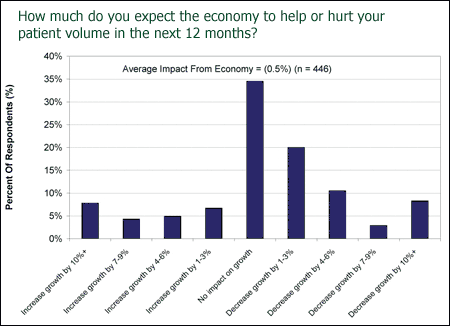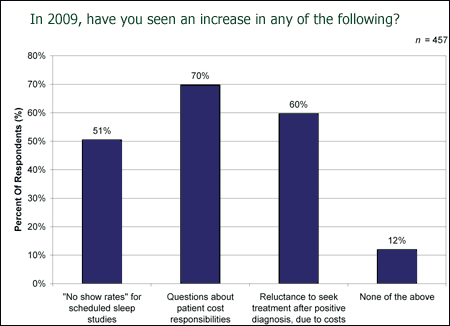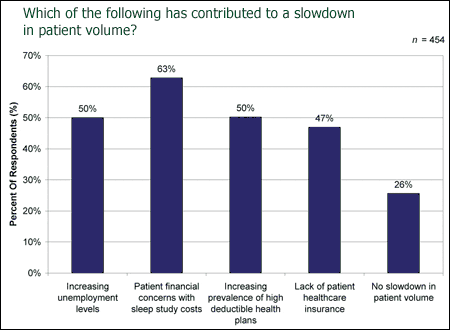Sleep Review has once again partnered with Wells Fargo Securities, LLC (formerly Wachovia Capital Markets, LLC) to survey the latest market trends in US sleep centers.
Our Q3 2009 results were compiled from the responses of 502 respondents and reveal that bed expansion and volume growth have slowed modestly over the last 6 months. Furthermore, the economy is having a noteworthy impact on growth overall.
SLEEP CENTERS SHOOK BY ECONOMY
Given the state of the US economy and investor concerns over the economy’s impact on the sleep apnea market and the broader health care industry, we again included several questions on this topic. About half (51%) of the respondents indicated that the economy has had a negative impact on patient volumes. We note that while CPAP is nearly universally covered by Medicare and insurers, patients may have to pay significant deductibles or co-payments “out-of-pocket.”
We added a new question to this survey to attempt to quantify the impact of the economy on the sleep centers. Looking out over the next 12 months, the sleep centers expect the economy to cause a 0.5% reduction in their volume growth. This is less than we would have expected but may reflect optimism on the part of the sleep centers that they have seen the worst of the recession. When asked about why patient volumes were being hurt, the most common response (from 63% of sleep centers) was concerns over out-of-pocket expenses.
 |
 |
 |
 |
 |
 |
Source: Wachovia Capital Markets, LLC Q3 2009 Sleep Center Survey
SLEEP CENTER EXPANSION HAS STABILIZED IN THE MID SINGLE DIGITS
For bed growth during the prior 12 months, respondents reported an increase of 4.1% during the past 12 months, reporting an average of 9.4 beds per respondent versus 9.0 beds per respondent 12 months ago. In our Q1 2009 Sleep Center Survey, respondents reported growth of 4.8%, and in our Q3 2008 Sleep Center Survey, respondents reported growth of 12.7%. We note that sleep center growth covers only part of the entire sleep market, as sleep center growth drives new diagnoses and flow generator sales, while mask sales are mostly driven by replacement sales.
Moreover, sleep center growth as defined in our survey represents only organic growth (beds per center) versus inorganic growth (new sleep centers). Finally, we note that many respondents are indicating the total number of beds for multiple sleep centers, which pushes the average number of beds per respondent higher (ie, we doubt that the average individual sleep center has 9+ beds). Overall, we think that the survey demonstrates that sleep center bed growth has stabilized in the low single digits.
During 2008, we estimate that flow generators (driven mainly by new patients) grew by 8% to 10% while masks (driven by both new patients and increasing replacement among existing patients) grew by 13% to 15%; combined, this put the market in the low teens.
Looking at 2009, we expect the US CPAP market to grow by 8% to 10% with 5% to 6% volume growth in new patients and 3% to 4% growth from increased mask replacement rates as home medical equipment providers strive to maximize recurring revenue opportunities to offset reimbursement declines.
In terms of expected bed growth during the next 12 months, our respondents expect faster sleep center capacity expansion in the next 12 months (12.8% to 10.6 beds per respondent) than the growth seen in the past 12 months. In our Q1 2009 survey, respondents expected growth in the next 12 months of 13.3%, and in our Q3 2008 survey, respondents expected growth in the next 12 months of 16.7%. Since our prior surveys indicate that sleep centers overestimate their projected growth rates by 150%-200%, we interpret this to mean that sleep center growth is likely to be stable in the mid single digits over the next 12 months.
PATIENT VOLUME GROWS BY 6% IN THE PAST 12 MONTHS. 9% FUTURE GROWTH EXPECTED
On average, respondents have seen patient volume grow 5.7% in the last 12 months (LTM) and expect 8.8% growth in the next 12 months (NTM), and we note that the most common responses were for 0% to 4% growth in both the LTM and the NTM.
These numbers are slightly different than the reported and expected bed growth rates (which were 4.1% and 12.8%, respectively). We are not sure how to explain the discrepancy between these two questions; one possible explanation might be that there is a lag between sleep center expansion and patient volume growth.
This is the fifth time we have asked this particular question, and it appears that there is a clear downward trend. LTM and NTM growth in this survey were both down modestly from our prior surveys. We can think of two reasons that patient volumes are slowing: (1) the sleep market is maturing and penetration is increasing (ie, the “law of large numbers”), and (2) the economic slowdown appears to have caused patients to decrease utilization of health care services.
ABOUT THE SURVEY
Among the roughly 12,500 sleep professionals sent the survey, 502 responded to one or more of the survey questions for a response rate of 4%. The responses were collected between June 23 and June 29, 2009. None of the questions in this survey were mandatory, therefore response rates varied from question to question (we note the response rate on each of the charts). We received responses from a range of sleep industry participants with sleep center directors/supervisors/managers (32% of respondents) and registered polysomnography technicians (31% of respondents) representing the most common titles. Responses also covered every geographic region and 49 of the 50 US states with the Midwest (32% of respondents) and Southeast (34% of respondents) the most heavily represented regions.





